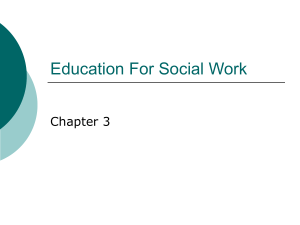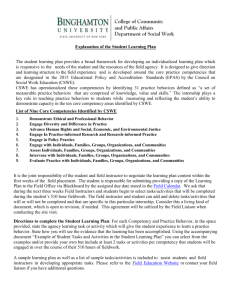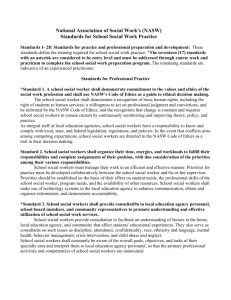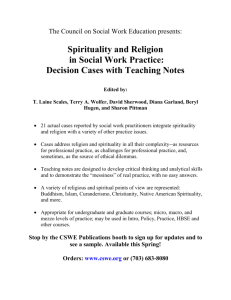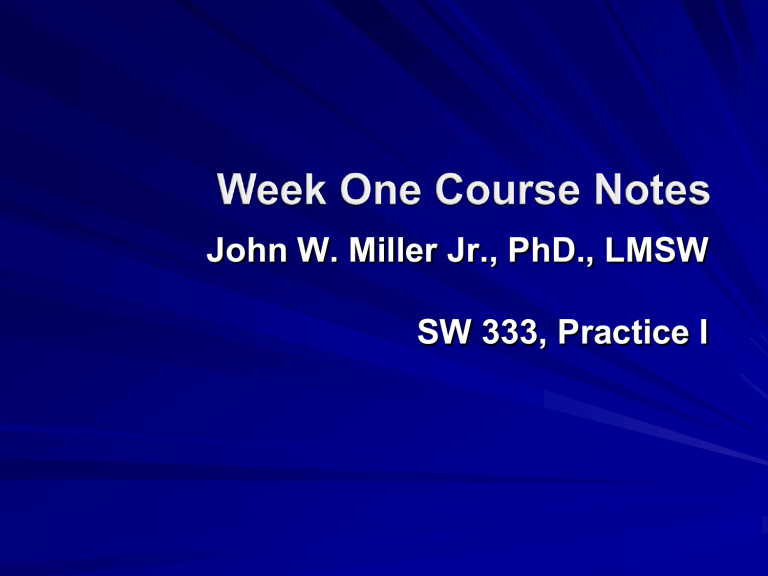
John W. Miller Jr., PhD., LMSW SW 333, Practice I What is the mission of social work? Social workers attempt to understand the interactions of individuals and families with their environment through the lenses of ecology and systems. Social workers look through a social justice lens in order to advocate for the poor, disadvantaged, disenfranchised, oppressed. Professional relationship standards Respect for an individual’s independence Assistance of client systems Improvement of social institutions Respect and acceptance of diversity Code of Ethics – Specifies rules of conduct to which members must adhere to remain in good standing within a professional organization. Accountability – To the profession and society of sanction – Bridges practitioners to consumers that utilize their services – Promotes accountability of practitioners to the profession For each client or case the social worker focuses on: A) Getting to know the person(s), family, group (developing the relationship). B) Problems and concerns: “What brings you here today?” C) Potential strengths and resources. D) Development of a plan with client and its implementation. E) Evaluation of progress if possible at a future time(s). NASW: “The primary mission of the social work profession is to enhance human wellbeing and help meet basic human needs, with particular attention to the needs of vulnerable, oppressed, and poor people.” CSWE: The social work profession is “committed to the enhancement of human well-being and to the alleviation of poverty and oppression.” 1. Enhance human well-being by increasing social justice (alleviating poverty, oppression, etc.). 2. Enhance social functioning of individuals, families, groups, organizations, communities by reaching goals, developing resources, lessoning distress. Social Functions Used: A. Prevention: Timely provision of services to those in need, before problems develop. B. Restoration: Restore functioning from physical or mental health issues. C. Remediation: Elimination or decrease in social problems. Largest group served. Person-In-Environment (PIE) focus: Use of PIE classification system for social functioning problems. Every person is living in some social environment which has resources as well as limitations and problems. PIE assessment helps social worker to assess environment and make use of other environmental resources to ameliorate problems (Karls & Wandrei, NASW, 1994). 3. “The planning, formulation and implementation of social policies, services, resources and programs needed to meet basic human needs and support the development of human capacities.” CSWE Carrying out process of social work At Micro, Mezzo, Macro social levels. 4. “The pursuit of policies, services, resources and programs through organizational or administrative advocacy and social or political action, to empower groups at risk and to promote social and economic justice.” CSWE Social plans and actions toward social justice. 5. “The development and testing of professional knowledge and skills related to these purposes.” CSWE Professional values are connected to societal values. Social work embodies society’s conscience for particular values. Values and purposes of social work education: 1. CSWE: “Social workers’ professional relationships are built on regard for individual worth and dignity, and are advanced by mutual participation, acceptance, confidentiality, honesty, and responsible handling of conflict.” Primary goal is service. 2. NASW: “Social workers respect the individual’s right to make independent decisions and to participate actively in the helping process”. Right to freely make own decisions through selfdetermination. Right to exercise freedom of choice in making decisions. Social workers must be flexible enough to be able to listen to many differing value positions on most moral and political issues. It is vital therefore that social workers are clear about their own values and how their values further the social work mission. 3. “ Social workers are committed to assisting client systems to obtain needed resources.” 4. “Social workers strive to make social institutions more humane and responsive to human needs.” Direct practice workers work to make the system more responsive. 5. “Social workers demonstrate respect for and acceptance of the unique characteristics of diverse populations.” Diversity Variables: race/ethnicity, culture, class, gender, sexual orientation, religion, ability, age, national origin. Social work is connected to social welfare as a social institution. Social welfare: In industrial societies, Whenever other major institutions, be they familial, religious, economic, or educational in nature, fall short in their helping and resource-providing functions, social welfare spans the gap Specifies rules of conduct for members: Expected responsibilities and behaviors. Accountability and sanctions when not living up to the code of ethics. Professionalism. Consumer protection. A. Often from other disciplines, as from social sciences. B. Assembled in unique ways. C. Categories of knowledge: 1. Human Behavior and the Social Environment: human bio-psychosocial-spiritual development through environmental systems. 2. Social Welfare and Services: political and systemic processes involved in social policy; seeking social justice. 3. Social Work Practice Methods: through 3 social practice levels A) Micro level practice: client systems (individual, couples, families). Face-to-face. B) Mezzo level practice: peers, groups – outside of intimacy of family relationships. C) Macro level practice: social planning; community organization; administration; evaluation. 4. Research 5. Field practicum May be competent in some social services and NOT others. Degree issues; also license issues. Areas of expertise. Keeping up with new research, theories. Need to be professional as a “competent practitioner” (what are the skills needed?). All theories may have “some truth”. Use of Ecological Systems Model: from biology. Habitat (physical and social settings within particular cultural contexts). Niche (statuses or roles occupied by community members) People both act and react to environment (ex: disability determined by environment). Client System: There are a variety of types of persons in need of social work services: Applicants: potential clients Referrals: referred by others Non-Voluntary Clients: come under pressure Legally Mandated Clients: legal pressure. Target System: People and problems that have to be influenced in order to reach goals. Equifinality: Same outcome can be reached from different starting places. Multifinality: Beginning from the same starting points may end in different outcomes. Choosing from the best theories at the time, which may change in time. – Is theory supported by empirical research? – If 2 interventions are effective, which offers less time, energy, money? Systems theory cannot be applied rigidly. Is it ethical? – Sensitive to context? What are the ethical and value implications of interventions? – Practitioner needs to have the skill to carry out intervention. – Ethno-culturally sensitive? – Is the intervention consistent with social work focus/values? Domain: Terms direct practice and clinical practice are fairly new to social work. Result of upheaval in society and social work field during 60s and 70s. Need for social work to address broad social problems. Generalist Practice is developed as foundation for BSW and 1st year MSW. Holistic and multilevel intervention approach. At MSW level may have specialization later in program. Work with individuals, couples, families, groups. More micro practice. Face-to-face but also working with other professionals, organizations, etc. Does clinical practice have same meaning as direct practice? Clinical practice may have a more psychotherapeutic meaning but book uses terms interchangeably. Issue with licenses: Ability to work with 3rd party payment. (need for M.S.W. + state license). B.S.W. social workers are trained at beginning level direct practice, which may have clinical component, but not independent of supervision. M.S.W. social workers need additional training for independent practice. Central to direct practice is PROBLEM SOLVING. Principles or Guides to Practice: Preferred beliefs about nature and causes of human problems, ability of people to change; value of relationships; nature of helping process. 1. Problems stem from a lack of… 2. S.W. negotiate and advocate for those in need. 3. People are capable of making own choices and growth. 4. Social workers have systemic educational role. 5. Value/belief negotiation with involuntary clients. 6. Authentic relationship with social worker. 7. All clients need respect, dignity. 8. Clients have strengths, can change. 9. More present to future orientation than past problem orientation. PRESENT FUTURE ORIENTATION System Linkage Roles A) Broker: Intermediary who assists in connecting people with resources; monitoring. B) Case Manager/Coordinator: For clients who need ongoing help. May provide direct services also. C) Mediator (neutral forum for disputants) OR Arbitrator (decision maker between client and service. D) Client Advocate: Working with and/or on behalf of client to get services/resources. 3. System Maintenance and Enhancement: A) Organizational Analyst: For service delivery when there are problems. B) Facilitator/expediter: Get services. C) Team member: on interdisciplinary team. Explain/implement social work mission. D) Consultant/Consultee: B.S.W. often consultee but may be consultant with other professionals because of some expertise. 4. Researcher/Research Consumer: evaluation. 5. System Development: Improve/expand agency services. A) Program Developer B) Planner C) Policy and Procedure Developer D) Advocate Cultural issues: historical and present inequalities/ preferences. Warm-up period for rapport with some cultures important, adolescents but not too long. Client dignity, worth: hospitality and empathic responding. Start where client is right now in the room (fear, anger, passivity, etc.). Language issues, interpreters; knowledge of the culture. After have explored problems, create with client goals (negotiate with client; client has major responsibility for creation of goals). Ending Interviews: standard endings (see p. 52). May want to summarize what have done, when will meet next, etc. Goal Attainment and Termination: Review goals and progress. Important for social worker to be FOCUSED and yet also RELATIONAL.


